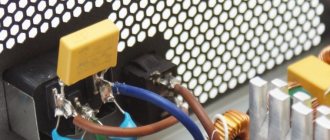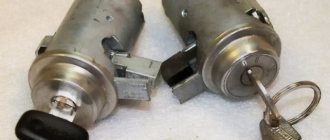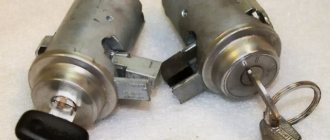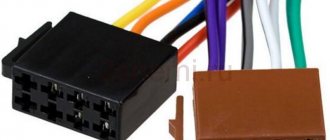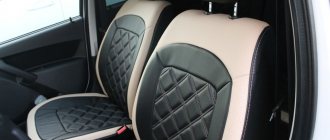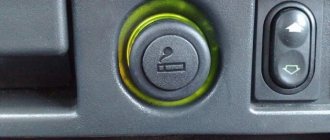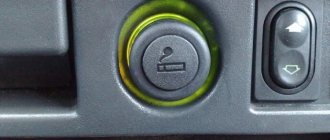The operation of powerful car subwoofers may be accompanied by problems associated with the high current consumption of these devices. You can notice this at low frequency peaks, when the subwoofer “chokes.”
This is explained by voltage drops at the subwoofer power input. An energy storage device, the role of which is played by the capacitance of a capacitor connected to the subwoofer power circuit, helps to correct the problem.
Why do you need a capacitor for a subwoofer?
An electrical capacitor is a two-pole device capable of accumulating, storing and releasing electrical charge. Structurally, it consists of two plates (plates) separated by a dielectric. The most important characteristic of a capacitor is its capacitance, which reflects the amount of energy that it can accumulate. The unit of measurement for capacitance is the farad. Of all types of capacitors, electrolytic capacitors have the highest capacity, as well as their further improved relatives - ionistors.
To understand why a capacitor is needed, let’s figure out what happens in the car’s electrical network when low-frequency car acoustics with a power of 1 kW or more are connected to it. A simple calculation shows that the current consumed by such devices reaches 100 amperes or more. The load is uneven, the maximums are reached at the moments of bass hits. The voltage drop when the car audio passes through the peak of the bass volume is caused by two factors:
- The presence of internal resistance of the battery, limiting its ability to quickly release current;
- The influence of the resistance of the connecting wires, causing a voltage drop.
The battery and capacitor are functionally similar. Both devices are capable of storing electrical energy and subsequently releasing it to the load. The capacitor does this much faster and more readily than the battery. This property underlies the idea of its application.
How to choose a capacitor
The required capacitor capacity depends on the power of the subwoofer. In order not to go into complex calculations, you can use a simple rule of thumb: for 1 kW of power, a capacitance of 1 farad is required. Exceeding this ratio is only beneficial. Therefore, the most common high-capacity capacitor on sale, 1 farad, can also be used for subwoofers with a power of less than 1 kW. The operating voltage of the capacitor must be at least 14 - 18 volts. Some models are equipped with a digital voltmeter indicator. This creates additional ease of use, and electronics that control the charge of the capacitor make this procedure easier.
Selecting a starting capacitor for an electric motor
A modern approach to this issue involves the use of special calculators on the Internet that perform quick and accurate calculations.
To carry out the calculation, you should know and enter the following indicators:
- Motor winding connection type: delta or star. The capacitance also depends on the type of connection.
- Engine power is one of the determining factors. This indicator is measured in Watts.
- Mains voltage is taken into account in calculations. As a rule, it can be 220 or 380 Volts.
- Power factor is a constant value that is often 0.9. However, it is possible to change this indicator during calculation.
- The efficiency of the electric motor also affects the calculations performed. This information, as well as others, can be found by studying the information printed by the manufacturer. If it is not there, you should enter the engine model on the Internet to search for information about what the efficiency is. You can also enter an approximate value, which is typical for such models. It is worth remembering that efficiency may vary depending on the condition of the electric motor.
Such information is entered into the appropriate fields and an automatic calculation is carried out. At the same time, we obtain the capacity of the working condensate, and the starting condensate should have an indicator 2.5 times greater.
You can carry out such a calculation yourself.
To do this, you can use the following formulas:
- For the star winding connection type, the capacitance is determined using the following formula: Cр=2800*I/U. In the case of a triangle connection of the windings, the formula Cр=4800*I/U is used. As you can see from the information above, the type of connection is the determining factor.
- The above formulas determine the need to calculate the amount of current that passes through the system. For this, the formula is used: I=P/1.73U?cos?. For the calculation you will need engine performance indicators.
- After calculating the current, you can find the capacitance indicator of the working capacitor.
- The starting one, as previously noted, should be 2 or 3 times higher in capacity than the working one.
When choosing, you should also consider the following nuances:
- Operating temperature range.
- Possible deviation from the calculated capacity.
- Insulation resistance.
- Loss tangent.
Usually, the above parameters are not paid much attention. However, they can be taken into account to create an ideal electric motor power system.
Overall dimensions can also be a determining factor. In this case, the following dependence can be distinguished:
- Increasing the capacitance leads to an increase in the diametrical size and outlet distance.
- The most common maximum diameter is 50 millimeters with a capacitance of 400 µF. At the same time, the height is 100 millimeters.
In addition, it is worth considering that on the market you can find models from foreign and domestic manufacturers. As a rule, foreign ones are more expensive, but also more reliable. Russian versions are also often used when creating an electric motor connection network.
How to connect a capacitor to a subwoofer
Installing a capacitor is not a complex procedure, but when performing it you need to be careful and follow some rules:
- To avoid a noticeable voltage drop, the wires connecting the capacitor and the amplifier should not be longer than 50 cm. For the same reason, the cross-section of the wires must be chosen large enough;
- Polarity must be observed. The positive wire from the battery is connected to the positive power terminal of the subwoofer amplifier and to the capacitor terminal marked with a “+” sign. The capacitor terminal marked “-” is connected to the car body and to the negative terminal of the amplifier power supply. If the amplifier was previously connected to ground, the negative terminal of the capacitor can be clamped with the same nut, while maintaining the length of the wires from the capacitor to the amplifier within the specified limits of 50 cm;
- When connecting a capacitor to an amplifier, it is better to use standard clamps to connect wires to its terminals. If they are not provided, you can use soldering. Twisted connections should be avoided as significant current flows through the capacitor.
Figure 1 illustrates the connection of a capacitor to a subwoofer.
How to charge a capacitor for a subwoofer
To connect to the car's electrical network, an already charged car capacitor should be used. The need to perform this action is explained by the properties of the capacitor, which were mentioned above. The capacitor charges as quickly as it discharges. Therefore, at the moment the discharged capacitor is turned on, the current load will be too high.
If the purchased subwoofer capacitor is equipped with electronics that control the charging current, you don’t have to worry; feel free to connect it to the power circuits. Otherwise, the capacitor should be charged before connection, limiting the current. It is convenient to use an ordinary car light bulb for this, turning it on against the power supply circuit. Figure 2 shows how to properly charge large capacitors.
If after reading the article you still have questions about connection, we recommend that you read the article “How to connect an amplifier in a car.”
How to choose an amplifier
They differ in the number (1-, 2-, 3-, 4-, 5-, 6-channel) channels and class (AB and D). Class AB - analog devices, with high power ratings, but an insignificant efficiency factor that would correspond to the power reserve. Class D - digital devices with high efficiency rates and a large power reserve, but they cannot always boast of excellent quality.
1-channel devices Monoblocks, as they are also called, are used for subwoofers, as they operate at a low load (1-2 Ohms). They are most often presented in class D, since for a subwoofer it is not the quality that is important, but the power of the sound. They are equipped with a developed low-frequency crossover and an external volume control.
2-channel They are used to connect a pair of speakers or connect a subwoofer using a bridge connection. If the power allows, they can also be connected via a coil to a car amplifier channel. 3-channel Today they are used extremely rarely, since they have been supplanted by four-channel devices.
The third channel was used to connect a subwoofer. 4-channel The most popular and widespread all over the world. They are used to amplify power in various ways: connecting to four speakers, two speakers and one subwoofer, or two subwoofers. The versatility of their application determines their demand.
5-channel Used to increase the power of four channels of front and side acoustics and one subwoofer. This is an economical option that includes amplification of all components of the audio system in the car, and its compact dimensions can significantly save space. 6-channel They are used extremely rarely, as they are not in demand by ordinary consumers who prefer simpler car audio systems.
Additional benefits of installing capacitors in cars
In addition to solving problems with the operation of the subwoofer, a capacitor connected to the car network has a positive effect on the operating mode of electrical equipment as a whole. This manifests itself as follows:
- The capacitor is a good filter for high-frequency components of the mains voltage that arise when switching loads and operating some electronic devices; its functions have a beneficial effect on the operation of all vehicle systems;
- The use of a capacitor makes it possible to smooth out voltage surges that occur when consumers on the on-board network are turned on and off, which allows the generator to operate in a more even mode;
- When the car is started by the starter, the capacitor, of course, takes an additional part in it, giving its charge to the on-board network. This is especially true in winter, when the battery’s ability to deliver current decreases, but the properties of the capacitor do not change.
The capacitor is installed, and you notice that your subwoofer is starting to play more interestingly. But if you try a little, you can make it play even better, we suggest you read the article “How to set up a subwoofer.”
How to eliminate additional load on car wiring
Low pressure electric fuel pump connection diagram
Autocapacitors have one serious drawback: the ability to self-discharge. This type of electrical devices is bad for your car battery. Especially if there are a lot of them and it’s cold winter outside. To solve this problem, there are many devices on the market that are connected only when voltage appears at one terminal.
Capacitors from popular companies are equipped with a very convenient function, for example, installing a voltmeter. This is necessary for visual instrumental monitoring of voltage sags.
When connecting to the starting system, be sure to check that there is no voltage on the starting wire when parked. If there is no potential on it, then the car's network will be blocked from the capacitor. It is very easy to perform manual switching yourself. To implement this, you just need to use a relay. The switch can be placed in any place where it is convenient.
What is a capacitor
A capacitor for a subwoofer is designed to accumulate (condense) energy and release it to the consumer at the right time. The storage device has low internal resistance and therefore releases the accumulated energy quite quickly. The peak of recoil occurs at the first moment, and then the charge drops sharply, as does the outgoing speed.
To be precise, the capacitor (storage) is used not for the subwoofer, but for the amplifier that controls this subwoofer.
It is important to understand that a capacitor is a consumer and does not generate energy itself.
True or not
To this day, on the Internet, in various forums and blogs, there are heated debates regarding the need or uselessness of such a storage device as a capacitor. The debates themselves, to the great regret of car audio lovers, do not lead to any truth. They are completely useless, due to the fact that opponents do not even have a basic school understanding of physics.
Note. The biggest nonsense that can be read from forums is that you need to install a capacitor based on only farads per kilowatt. Such recommendations are fundamentally wrong, since you will not understand where they came from.
So, to lift the veil somewhat, let's go back to our physics lessons. As valuable knowledge is updated in our memory, all myths will disappear like morning smoke.
Differences between a capacitor and a battery
- A capacitor for a woofer is the same power consumer that is not capable of generating electricity itself. But it is capable of accumulating it and then consuming it for its own leaks, but not for battery leaks;
- The capacitor's task is to accumulate energy and then release it to the consumer. The drive itself has extremely low internal resistance and for this reason “parts” with energy very quickly (by the way, it does not accumulate it slowly either).
Note. The difference between a capacitor and a battery is that the peak energy output of a capacitor occurs only for the first moment, and then there is a sharp drop in charge. Thus, the recoil speed drops along with the charge.
Differences between a capacitor and an ionistor
Capacitor for subwoofer
Ionistors are what most music lovers carry in their trunks. It differs from a capacitor in the following parameters:
- Huge losses;
- Greater resistance;
- Releases charge much more slowly;
- It costs several times less than a capacitor of the same capacity.
The optimal operating time of the ionistor is: 1 sec/83 cool.
Checking the ionistor
It is recommended to check the ionistor to clearly understand how it works:
- We connect the ionistor to the speaker system with power drawdowns;
- We start it up and observe that the voltage at the terminals increases. So far so good;
- We increase the volume and notice that the voltage drops from 13 to 10 volts.
Note. All this means that at the first hit of the subwoofer, the charge will drop and the ionistor will turn into an extra power component, since it is useful and active only when its charge is greater than the voltage in the network.
This situation among car audio enthusiasts is called sag, but it can be much worse if thin, low-quality wires and cheap copper-plated aluminum are used in the power supply. In this case, cable subsidence is also added to the normal subsidence.
Note. You need to know the dangers of cable sag. The fact is that with a sharp increase in consumption, reactance occurs. The more and faster the user tries to take energy from the cable, the more it (the cable) will interfere with this (if it is thin and long).
The problem of a cheap and low-quality cable will also be reflected in the ionistor, which, having discharged, will no longer be able to receive energy.
Do you need a capacitor for a subwoofer?
Smoothing out voltage dips during peak loads is what a subwoofer capacitor is for. It would seem like a useful thing, but only at first glance.
The fact is that by the word “capacitor” most people mean an ionistor. The definition of the word can be googled, but simply put, it is something between a capacitor and a chemical current source.
Typical "capacitor"
Unfortunately, in the form in which audio manufacturers offer us, ionistors have a number of disadvantages:
- big losses
- high resistance compared to a capacitor
- low output speed compared to a capacitor
The advantages include low cost, again in comparison with a capacitor of the same capacity.
A capacitor is not needed in the system; if it corrects some problems, it means that the power supply is not organized correctly!
In connection with the last statement, let's look at several situations.
An example of bad wiring
If you have a very powerful sub link, a loud system and you want to rock the area or even participate in sound pressure competitions, then such drives will not help you, in this situation you need to install real high-quality products, the cost of which starts from $300 . And if you are at this level, then it will be much more efficient to spend money on laying wiring of the maximum cross-section, replacing an acid battery with an AGM, or installing additional batteries.
Additional food
Application of capacitor
It turns out that almost always using a capacitor does not make sense. But then what are they even needed for? In addition, they can be found in high-level systems!
Brax IPC 27000r.
The fact is that a real high-quality capacitor well suppresses high-frequency and low-frequency interference, voltage changes when fans are turned on, electrical noise, and the like, so in high-level projects (usually focused on sound quality) with a large amount of equipment, the use of these devices is justified, and sometimes necessary.
PS: Be careful about custom articles and their thoughtless copies about the benefits and necessity of capacitors in an everyday system.
Why do you need a separate battery for car audio?
For stable operation of a car amplifier, the on-board network must have a voltage of 12.8 - 14 W.
Car owners who decide to improve the sound quality and buy the necessary equipment are often disappointed, never achieving a result, no matter how hard they try to configure the system. The reason for this is voltage sags. What causes them: Unsuitable power cables, power distributors, fuse holders or batteries are used.
For stable operation of a car amplifier, the on-board network must have a voltage of 12.8 - 14 W. This indicator will easily “sag” (for example, when playing bass) if the power system has insufficient current conductivity. During drawdowns, the power of the amplifiers drops, which reduces the sound quality of the audio system.
In this situation, you can “blame” the standard battery. Due to its high internal resistance, it cannot supply enough electricity to the amplifiers to process the incoming audio signal. Drawdowns also occur due to its distance from the amplifiers (current travels longer through long cables).
The second point is that the task of the “native” battery is reduced to providing energy to the on-board network and the starter. There is not always enough of it anyway; there are cars with “tired” batteries that are undercharged.
And if you add car audio, which also requires power, the battery may even die out of the blue, and then it won’t be possible to start. After 2–3 deep discharges, the power source can be discarded.
Pros and cons of two batteries in a car
If there are two batteries, careful monitoring of the charging current and state of charge is required.
As for the advantages, firstly, this is a separate power source for:
Secondly, a separate battery for car audio, because the sound system requires a decent amount of energy. And when the engine is idling, the battery is not recharged, so you may be able to listen to music at a picnic, but not for long.
Usually, instead of a similar standard battery, a gel battery is used for car audio. It is durable, without the risk of plates shedding (when delivering critical current).
Operating principle of a capacitor
For modern subwoofers, short-term peaks are enough to start drawing more current. As a result, it cannot fully provide energy to the battery. Even the thick wires that feed the amplifier do not have such resistance that will cause a decrease in voltage at the moments of the pulses.
Connecting a subwoofer to an amplifier and capacitor
As a result, the functionality of the amplifier is reduced. To eliminate such phenomena, it is necessary to install a drive in the car. It is an electrolytic device with a large capacity. Connected in parallel with respect to the power circuits on the amplifiers. The resistance of the equipment is very low, and the current is transferred to the amplifier at lightning speed. Thanks to this, the occurrence of subwoofer malfunctions is excluded. Just as quickly, the capacitor is recharged again and “gives” a portion of the current back.
So, what is a subwoofer capacitor for? In simple words, we can say this: the device accumulates and quickly transmits electricity. In technology, this function is used to improve the sound of a car radio.
Capacitor
There is an opinion that the current storage prolongs the life of the battery or facilitates its operation. And some car owners install devices based on this consideration. But this is a proven myth! The storage device does not produce energy. It only accumulates electricity and delivers it to the consumer.
Review of capacitors for a snack
Brax IPC
What kind of capacitor is needed for a subwoofer
Capacitor costing 300 US dollars. The model name IPC stands for “intelligent power capacitor.” It has the following features:
- The user will find in this model a luxurious, superbly finished, clearly thought out device with the highest electrical performance;
- The length of the capacitor body is 280 mm, and the diameter is 75 mm;
- The operating principle is based on automation, which will provide charging with a normalized current and protect the acoustics from overvoltage;
- The Brax capacitor operates at 17.5 V, if connected incorrectly, automatically connected to the power network and disconnected;
- Provides a continuous indication of the voltage at the amplifier terminals (see How to connect an amplifier and subwoofer to a car radio: you are your own master);
- The capacitor is made in a stylish, beautiful case with a transparent head, in the center of which a 3-charge digital indicator is displayed. This indicator becomes active as soon as it senses the slightest voltage ripple on the amplifier and shows a voltage of up to 0.1 V;
- The capacitor readings are not carried out by continuous blinking, as on some cheap models, but are averaged with a time constant of about 1.5 s;
- For rapid fluctuations, the answer is another indicator, operating on 2 LEDs. If one of them or two blinks at once, this indicates short-term voltage ripples;
- There is also a third indicator called CPS. It is needed to report danger: if it lights up red, the polarity is reversed; if it lights up yellow, the overvoltage protection has tripped.
In a word, this is a gorgeous device that we recommend everyone buy. In addition to purely intellectual capabilities, this capacitor has virtually no internal resistance and it passes through at a record low.
Power Ampere SPV 100D
An excellent electronic capacitor with declared internal resistance characteristics. The approximate price of the device is $250. It has the following features:
- Stated internal resistance characteristics: 1.8 mOhm/120 Hz and 1 mOhm/20 kHz;
- The advantages of this capacitor will be fully manifested in conjunction with a high-quality amplifier (where power supplies, as a rule, operate at a higher frequency);
- The head of the device is filled with electronics, which ensures smooth charging in 10 seconds;
- You can know that charging is in progress by the blinking indicators;
- If the voltage in the network crosses the value limit of 15.5 V, the protection is triggered immediately. If the voltage drops (11 V), the capacitor turns off and goes into hibernation.
Power Ampere Capacitor Operation Chart
What types of automotive capacitors are there?
Today, many different capacitors for cars are already produced. From the simplest and cheapest models, to elite and expensive ones, with a large capacity of 20F. Such capacious installations are used in powerful equipment that has a distributor and has the ability to connect more than two amplifiers at the same time.
Automotive capacitor
The choice of device depends on several factors. Basically, you need to consider the power of the car's battery. Never buy equipment if it looks questionable. Capacitors have the “property” of exploding. And even the slightest violation of the integrity of the structure can lead to an explosion.
When inspecting the device in a store, you need to pay attention to the presence of protection on the terminals. They protect the system from accidental short circuits. It is also important to study the ease of connection and installation.
Automotive capacitor
What equipment capacity is needed?
There is no exact formula here. Many follow this rule: 1 kW. from the power of the amplifier must correspond to 1 F of the capacitor capacitance. This is normal and most users purchase the design precisely for this reason. For example, if your car has an audio system with a power of 2 kW, then you need to purchase a drive with a capacity of 2 Farads. But experts recommend choosing a device with a large supply of capacity.
Some models have built-in voltmeters. They control the system voltage level. Devices with voltmeters are more expensive.
general information
The best capacitors for acoustics
So why do you need a capacitor? As you know, the price for it is not small and not all motorists, even lovers of good sound, want to cut their budget once again. On the other hand, every music lover sooner or later acquires a powerful speaker system or brings it to perfection. This is very good, but the more powerful the system, the more energy you give it.
Note. The battery is not capable of delivering such energy, as a result of which a drawdown occurs (what this means is described in detail below). The drawdown is expressed by the fact that the car’s headlights begin to “blink,” the amplifier’s power drops, and the bass coming from the subwoofer, which was previously clear, becomes “blurry.” In some and especially severe cases, a sharp drop in amplifier voltage leads to clipping, which can damage the speakers.
How to install a drive in a car
Installation is usually carried out close to the amplifier. This prevents the amplitude of the electricity from decreasing. Since the connecting wires always produce resistance due to the low resistance of the capacitor. It is important to know that a distance of no more than 60 cm should be maintained from the amplifier to the capacitor. The smaller this gap, the better the installation.
Connecting a subwoofer
Some people mount the structure directly on the amplifier. It is convenient, practical and neat looking. Doesn't take up much space in the cabin. But there are other ways to arrange the system. For example, many car enthusiasts have gotten used to placing the amplifier in the luggage compartment, on the side of the wall. And the capacitor is on the opposite wall. It looks nice, but from a technical point of view it is not practical, since the distance is too large.
An important point: when installing a current storage device, it is not allowed to connect it uncharged to the positive and negative power wires. Because with such contact, the device will be “powered” by current from the battery, and this leads to burning of the fuse.
To avoid such troubles, manufacturers began to attach special circuits to their products, according to which the capacitors are charged gradually. If such a circuit is not available, then you need to charge the equipment in advance through a 12-volt light bulb. If the light goes out during installation of the device, it means it is sufficiently charged.
Capacitor for a subwoofer in a car
Top 5 devices of 2021
Based on consumer reviews, the 5 best capacitors for a subwoofer have been selected, showing good results and a long service life. These include products from well-known brands, suitable for use by both novice and experienced car audio engineers.
Connection recommendations
- The system can be connected to circuits of any power. Even in cases where one amplifier built into the head unit is working. But when installing a capacitor in an audio system equipped with an external amplifier, the first step is to start with the minimum system power (from 250 to 300 W).
- Such a device does not have to be connected only to a sound system that has a special battery. It’s just that such a “sonic” battery can quickly supply current and just as quickly unload the car’s network.
- If you are going to connect the device yourself, it is better to have protective circuits. Also, you should have on hand devices that monitor the state of the on-board network.
Be sure to follow the diagram when connecting elements. It has visual drawings showing the location of electrical circuits. All important information is also present on the diagram.
Many drivers of cars of both expensive brands and budget models install good acoustic systems in the interior. To achieve high-quality sound at low frequencies, you need to add an electrolytic capacitor for the subwoofer to the audio system amplifier.
Pros and cons of different batteries as a power source for car audio
Although all types have different designs, they work the same. It is important to know that not every car audio battery is suitable for good sounding music. Which one to choose?
Why aren't regular lead-acid (WET) batteries used for car audio?
Pros and cons of gel (GEL) batteries for car audio
Advantages and disadvantages of AGM as a battery for car audio
Connecting a second battery in a car for car audio is quite complicated for a beginner, but simple for an experienced user. Having considered all the advantages and disadvantages, you can choose either a battery for a subwoofer or for any audio system. Gel and AGM batteries meet all the requirements for creating high-quality sound. Today, among all types, experts single out and recommend installing a gel or AGM battery for car audio.
How to choose a capacitor
When choosing a capacitor for a car electrical system, you should take into account 2 important parameters: capacitance and equivalent series resistance (ESR, Equivalent Serial Resistance), which determines the speed of release of the accumulated charge. The capacity required is large, compared to ordinary electrolytic storage devices (in jargon - “electrolytes”).
For modern automotive devices, drives are offered with capacities ranging from tenths of a farad to several tens of farads, with internal resistance from several hundredths to thousandths of an ohm. The lower the internal resistance, the more efficiently the electrolyte releases its charge.
The higher the power of the audio amplifier, the greater the electrolyte capacity required. It is estimated as follows: per 1 kW of amplifier power, a minimum of 1 farad is required. If the capacity is larger, it will not harm the system. You should buy drives of proven models from reliable suppliers.
Popular brands range in price from $40 to $400 or more.
Expensive models are equipped with a protection system against overvoltage and switching on in the wrong polarity (i.e. when plus is supplied to minus, and minus to plus).
Typical characteristics of drives from one trusted manufacturer for cars with a 12 V power supply are shown in Table 1.
| Models type 1, 2 and 3 | |
| Nominal capacity, farad | 1/1,5/2 |
| Permissible error of capacitance value, % | + / — 5 |
| Maximum operating voltage, V | 16 |
| Peak value of pulse voltage, V | 24 |
| Equivalent series resistance (ESR), Ohm | 0016 |
| Operating temperature, °C | -10 to +105 |
| Dimensions (diameter*height), mm | 76*245 |
| Weight, kg | 1,5 |
Installing a dubious inexpensive capacitor in the system will be useless due to the fact that its actual capacity, as established by practice and tests by independent experts, is 10 or more times less than the declared one, and the ESR value does not meet the standards. Since the electrolyte housing is sealed and cannot be opened by the buyer, unscrupulous manufacturers take advantage of this and save on materials for the linings; they put broken bricks and pieces of cement on the bottom for weight, and fill the remaining space with resin.
There are so many similar products on the market for storage devices for car audio systems that a myth has formed among car enthusiasts about the uselessness of installing a capacitor in a car.
The perfect combination
Pioneer car radio connection diagram
As mentioned above, car audio has the right to be called that if it involves a trio (sub, amplifier and capacitor). Let's try to figure out which combination can be called ideal.
Woofer Mystery MJB 12, amplifier Sony XM-504Z and capacitor Stinger SPC111
A powerful trio that delivers perfect sound. At the same time, everything is in a budget option and you don’t have to pay extra.
Selection of amplifier, subwoofer and capacitor
Woofer Specifications
| Mystery Corps MJB 12 | High quality MDF |
| Diffuser | High quality chrome plated injection molding |
| Suspension | Butyl rubber |
| Magnet/magnetic system - weight | 40 oz/80 oz |
| Voice coil | 2" aluminum, covered with cardboard |
| Case dimensions, mm | 450/418/367 |
| Peak power, W | 250-500 |
| approximate cost | 4-5 thousand rubles |
Specifications of the Sony XM 504Z amplifier
| Dimensions, mm | 350/233/55 |
| Peak power, Ohm/W | 4/100 – 2/125 – 1/250 |
| Channels, number | 4/3 |
| Power supply | MOSFET transistors |
| approximate price | 3-4 thousand rubles |
Technical characteristics of the Stinger 111 capacitor
| Capacitance, farad | 1 |
| Voltage range, V | 16-20 |
| Internal resistance, mOhm/Hz | 1,5/120 |
| Voltmeter | Has digital/LED display red/3 segments/auto power off and on |
| Diameter, mm | 75 |
| Height, mm | 250 |
| Case color | grey |
